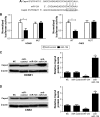miR-124 suppresses proliferation and invasion of nasopharyngeal carcinoma cells through the Wnt/β-catenin signaling pathway by targeting Capn4
- PMID: 28579809
- PMCID: PMC5449109
- DOI: 10.2147/OTT.S135563
miR-124 suppresses proliferation and invasion of nasopharyngeal carcinoma cells through the Wnt/β-catenin signaling pathway by targeting Capn4
Abstract
Background: Recent studies have demonstrated that microRNA 124 (miR-124) acts as a tumor suppressor in nasopharyngeal carcinoma (NPC); however, the exact molecular mechanism by which miR-124 exerts tumor suppression has not been well elucidated.
Materials and methods: We performed quantitative real-time PCR (qRT-PCR) to measure the expression of metastasis associated lung adenocarcinoma transcript 1, miR-124, and calpain small subunit 1 (Capn4) mRNAs in NPC cell lines. We also performed western blot analysis to detect the levels of Capn4. Furthermore, we performed MTT assay and transwell invasion assay to determine the proliferation and invasion ability of two NPC cell lines, namely, HONE1 and CNE2 cells, respectively. The verification of targets of miR-124 was performed using prediction softwares and luciferase reporter analysis.
Results: According to our results, the expression of Capn4 was found to be elevated, whereas the expression of miR-124 was lowered in NPC cell lines compared with normal nasopharyngeal cells. When we preformed overexpression of miR-124, it suppressed the proliferation and invasion of NPC cells. Moreover, miR-124 suppressed the expression of Capn4 by targeting Capn4 in HONE1 and CNE2 cells. When we preformed overexpression of Capn4, it reversed the inhibitory effect of miR-124 on the proliferation and invasion of NPC cells. Furthermore, miR-124-Capn4 axis decreased the levels of β-catenin, cyclin D1, and c-Myc, the components of the Wnt/β-catenin signaling pathway.
Conclusion: The suppression of proliferation and invasion of NPC cells by miR-124 were achieved by the regulation of Wnt/β-catenin signaling pathway by targeting Capn4. The results of this study revealed a novel miR-124-Capn4 regulatory axis in NPC cell lines, providing a better understanding of the pathogenesis of NPC and a promising therapeutic target for patients with NPC.
Keywords: Calpain small subunit 1; NPC; miR-124.
Conflict of interest statement
Disclosure The authors report no conflicts of interest in this work.
Figures






Similar articles
-
MALAT1/miR-124/Capn4 axis regulates proliferation, invasion and EMT in nasopharyngeal carcinoma cells.Cancer Biol Ther. 2017 Oct 3;18(10):792-800. doi: 10.1080/15384047.2017.1373214. Epub 2017 Aug 31. Cancer Biol Ther. 2017. PMID: 28857668 Free PMC article.
-
Capn4 expression is modulated by microRNA-520b and exerts an oncogenic role in prostate cancer cells by promoting Wnt/β-catenin signaling.Biomed Pharmacother. 2018 Dec;108:467-475. doi: 10.1016/j.biopha.2018.09.019. Epub 2018 Sep 18. Biomed Pharmacother. 2018. PMID: 30241050
-
The Long Noncoding RNA NEAT1 Targets miR-34a-5p and Drives Nasopharyngeal Carcinoma Progression via Wnt/β-Catenin Signaling.Yonsei Med J. 2019 Apr;60(4):336-345. doi: 10.3349/ymj.2019.60.4.336. Yonsei Med J. 2019. PMID: 30900419 Free PMC article.
-
Circular RNA ABCB10 promotes cell proliferation and invasion, but inhibits apoptosis via regulating the microRNA‑1271‑mediated Capn4/Wnt/β‑catenin signaling pathway in epithelial ovarian cancer.Mol Med Rep. 2021 May;23(5):387. doi: 10.3892/mmr.2021.12026. Epub 2021 Mar 24. Mol Med Rep. 2021. PMID: 33760208 Free PMC article.
-
MiR-337-3p suppresses the proliferation and metastasis of clear cell renal cell carcinoma cells via modulating Capn4.Cancer Biomark. 2018;23(4):515-525. doi: 10.3233/CBM-181645. Cancer Biomark. 2018. PMID: 30452399
Cited by
-
MicroRNA-124-3p inhibited progression of nasopharyngeal carcinoma by interaction with PCDH8 and the inactivation of PI3K/AKT/mTOR pathway.J Cancer. 2021 Jun 11;12(16):4933-4944. doi: 10.7150/jca.57152. eCollection 2021. J Cancer. 2021. PMID: 34234863 Free PMC article.
-
Long noncoding RNA NEAT1 promotes nasopharyngeal carcinoma progression through regulation of miR-124/NF-κB pathway.Onco Targets Ther. 2017 Dec 11;10:5843-5853. doi: 10.2147/OTT.S151800. eCollection 2017. Onco Targets Ther. 2017. Retraction in: Onco Targets Ther. 2023 Jul 26;16:639-640. doi: 10.2147/OTT.S432288. PMID: 29270022 Free PMC article. Retracted.
-
miR-124 Intensified Oxaliplatin-Based Chemotherapy by Targeting CAPN2 in Colorectal Cancer.Mol Ther Oncolytics. 2020 Apr 14;17:320-331. doi: 10.1016/j.omto.2020.04.003. eCollection 2020 Jun 26. Mol Ther Oncolytics. 2020. PMID: 32382656 Free PMC article.
-
Upregulation of miR-124-3p by Liver X Receptor Inhibits the Growth of Hepatocellular Carcinoma Cells Via Suppressing Cyclin D1 and CDK6.Technol Cancer Res Treat. 2020 Jan-Dec;19:1533033820967473. doi: 10.1177/1533033820967473. Technol Cancer Res Treat. 2020. PMID: 33073697 Free PMC article.
-
Upregulation of circRNA_0000285 serves as a prognostic biomarker for nasopharyngeal carcinoma and is involved in radiosensitivity.Oncol Lett. 2018 Nov;16(5):6495-6501. doi: 10.3892/ol.2018.9471. Epub 2018 Sep 20. Oncol Lett. 2018. PMID: 30405788 Free PMC article.
References
-
- Lee KT, Tan JK, Lam AK, Gan SY. MicroRNAs serving as potential biomarkers and therapeutic targets in nasopharyngeal carcinoma: a critical review. Crit Rev Oncol Hematol. 2016;103:1–9. - PubMed
-
- Chang ET, Adami HO. The enigmatic epidemiology of nasopharyngeal carcinoma. Cancer Epidemiol Biomarkers Prev. 2006;15(10):1765–1777. - PubMed
-
- He L, Hannon GJ. MicroRNAs: small RNAs with a big role in gene regulation. Nat Rev Genet. 2004;5(7):522–531. - PubMed
LinkOut - more resources
Full Text Sources
Other Literature Sources
Research Materials
Miscellaneous

